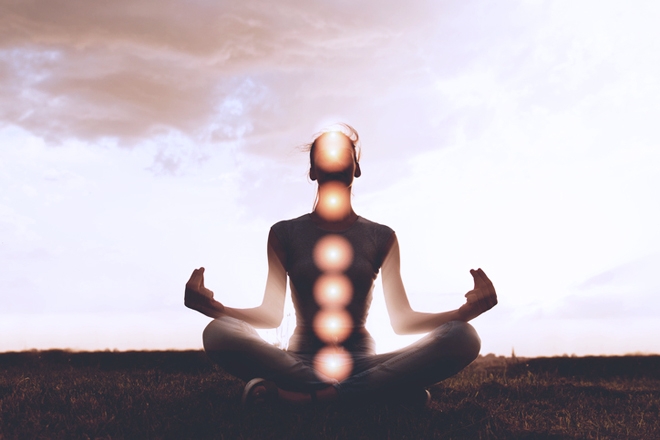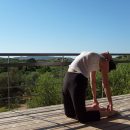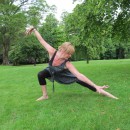In part 1 a brief introduction to the yamas was given, in part 2 we will begin to look at the individual yamas and how they apply in day to day living. As I mentioned in the previous article I would like to suggest that the yamas be considered as how to be kind to others, they guide our actions toward the benefit of all things. Alternatives are therefore offered as options to work toward as opposed to away from which in psychological circles is considered to be much more motivational and empowering to individuals.
- Ahimsa- is classically translated as non-violence. Refraining from violence in thought, word and deed
Alternative suggestions: Peacefulness, harmlessness, gentleness, love
Ahimsa is the foundation of all the other yamas. Harmlessness means not hurting, injuring, killing ourselves, another creature, or the world in which we live. Quite simply this encourages us to be compassionate to ourselves, others and nature and to indeed love ourselves, others and nature. Violence, its opposite is considered to be a reaction to fear born out of ignorance. When we allow ourselves to act out of ignorance, we are deluded and act from a place of fear, from fear arises insecurity and from insecurity comes greed and frustration which leads to irritation and anger out of which aggression and violence may surface.
What actually constitutes violence though is much harder to define and I’m sure will provoke many different thoughts in different people. It’s very easy to allow the ego to get in the way here and cast judgments on people that behave in certain ways or partake of certain behaviours (often things that we personally would never do, would we?). On a course I was on recently the teacher presented an interesting point into the discussion we were having; he asked every murderer in the room to raise their hand. As you can imagine no one felt that they should raise their hand after all none of us had killed another human being. However, if we’re all honest with ourselves we would all have to admit that at some point in our past we have killed something in that whether intentionally or not we have permitted death to another sentient being. As I drive down the motorway in summer, my windscreen is splattered with bugs, I’m quite sure I’ve trodden on small creatures and ingested them in food. What I think differentiates these behaviours from those of murder though is my intent. Violence is not defined by the act itself but by whether the desire exists to see another being harmed as a result of the actions I’m taking. Thus harmlessness is the desire to refrain from harming another in thought, word and deed. All must apply for us to be totally acting from the point of view of gentleness and harmlessness, if we secretly harbour nasty thoughts whilst carrying out ”good actions this doesn’t really constitute ahimsa as we are still directing harm on the object of our distaste on a more subtle energy, a form of voodoo perhaps.
Another interesting area to discuss would be that of for example a hijacker holding people hostage. No agreement can be reached and the hijacker has claimed that he will kill the hostages. The SAS are called in, one of the team shoots the hijacker and killing them, which begs the question did the SAS soldier violate ahimsa? Instinctively we may say yes given that a life has been taken, however how we may need first to consider how many lives would have been taken if the soldier had not killed the hijacker. Would allowing a massacre to take place have been an even greater violation of ahimsa? The answer to this again probably lies with the motivation. If the aim was to protect others and preserve life ahimsa was probably being adhered to, however if the soldier harboured violent or hateful thoughts towards the hijacker it may be considered to have broken with ahimsa. Taking this further, even those of us not involved in any action yet holding hateful, destructive thoughts have violated ahimsa. Thus it is a complex area and it clearly demonstrates how difficult it is to truly judge the actions of others as we rarely have knowledge of the intent or motivation behind their action.
Our thoughts whether actioned or not have an impact on our lives and those of others. Our individual negative thoughts influence the collective consciousness of the planet we live in. Many philosophical and religious texts discuss this. The bible tells us, “What you sow, so shall you reap”. The scientific and spiritual law of cause and effect, demonstrates that each cause leads to an effect and each result is the result of a certain cause. My wonderful Theosophy teacher Eric McGough, once posed the question, “Who or what creates war?” The answer he gave was that we all do, each and every one of us, regardless of whether we are physically taking part in the combat. Every negative, thought we have, every negative deed or action we carry out contributes to the negativity which accumulates. Due to the law of homogeneity, thought forms attract others of a similar nature or they themselves are attracted by stronger forms. The affect becomes accumulative and immensely powerful, we tune into the energy and are influenced by it hence the old adage “there’s something in the air”. At a critical stage this energy needs an outlet, in needs to transform, energy cannot disappear it can only be transformed into another form. Whilst the decision to permit war may not directly lie with us, we all are involved form the energetic perspective. The state of the world reflects the consciousness of mankind of which we as an individual are also a part. Energy follows thought thus it stands to reason that we would do better to train our mind to focus on wellbeing, harmony and compassion. This is not always easy, it requires patience, courage, strength and a deep understanding that ultimately we are all intimately connected and by harming another we are ultimatelyharming ourselves.
I would propose that ahimsa is considered as abstaining from ill will towards all living beings and instead adopting an attitude of helpfulness and kindness towards all things. This can be summed up quite simply as love. Unconditional love, takes time and this Yama could be approached initially as compassion and respect for all living beings in thought, word and deed. Whilst we can take steps to prevent avoidable harm we cannot, with the very best of intentions, be totally free from harming our environment no matter how hard we try. We need to eat to live yet studies show that even plants feel pain (The Secret Life of Plants 1973 Peter Tompkins and Christopher Bird). The simple act of picking flowers or fruit from a tree is therefore harmful. Sources encourage us to ask permission before we take, everything is an exchange, by accepting the fruits of nature we in turn need to give something back, to nurture, supply water, food and a safe environment for them, we are their guardians and in return for our care they nurture us and gift us with life. There are people who talk and even sing to their plants them and nature responds with growth and bountiful abundance. These are laws of nature and supported by science. It’s beautiful, synergistic cooperation in action.
Even if we have to unwillingly harm someone or something do it with a sense of love. We refrain from causing or wishing harm, distress or pain to another living being, ourselves or the environment. With practice we can rise above anger, aggression, fear, hatred, jealousy, envy and attachment. With perfection one can realise the unity and oneness of all life and seek to allow universal love, peace and harmony to prevail.
Mahatma Ghandi based his life on adopting ahimsa and achieved great things through his peaceful protests. Whilst he was in was in no way the originator of the principle of non-violence, he was the first to apply it in the political field on a huge scale
"There are many causes that I am prepared to die for but no causes that I am prepared to kill for."
He is often quoted as saying
“An eye for an eye will make the whole world blind”.
He writes in his book for Pacifists
“The science of war leads one to dictatorship, pure and simple. The science of non-violence alone can lead one to pure democracy...Power based on love is thousand times more effective and permanent than power derived from fear of punishment....It is a blasphemy to say non-violence can be practiced only by individuals and never by nations which are composed of individuals...The nearest approach to purest anarchy would be a democracy based on non-violence...A society organised and run on the basis of complete non-violence would be the purest anarchy”
On October 14th, 1964, Dr Martin Luther King an American Baptist Ministerand activist who was a leader in the Civil Rights Movement received the Nobel Peace Prize for creating racial equality through non- violent resistanceIn his acceptance speech he said,
“Nonviolence is the answer to the crucial political and moral questions of our time: the need for man to overcome oppression and violence without resorting to oppression and violence. Man must evolve for all human conflict a method which rejects revenge, aggression and retaliation. The foundation of such a method is love”.
King wrote Stride to Freedom which included the chapter Pilgrimage to non- violence. King described his notion of non violence to be one which seeks to win an opponent to friendship, rather than to humiliate or defeat him
“Nonviolence is a powerful and just weapon, which cuts without wounding and ennobles the man who wields it. It is a sword that heals”
The Dalai Lama is a modern day example of ahimsa in action, despite living in exile as a result of the Chinese occupation of his country; he has only ever displayed compassion and love towards the occupiers. The Dalai Lama describes compassion as
“The state of mind that is non violent, none harming and non aggressive. It is a mental attitude based on the wish for others to be free of their suffering and is associated with a sense of commitment, responsibility and respect towards others”
Since April 2016 indigenous water protectors and worldwide supporters have gone to Standing Rock, Dakota, USA by the hundreds in order to peacefully protest against an oil pipeline that endangers water, potentially poisoning the water for hundreds of thousands, even millions of people whilst desecrating the sacred land of the Native American people. They are unarmed, peaceful people whose resistance is firmly rooted in principles of ahimsa/ nonviolence and the spirit of prayer and solidarity. Despite standing in the face of violence on a daily basis, Standing Rock’s water protectors stand together and continue to uphold peaceful protest. They too demonstrate that rare kind of satyagraha (a policy of passive political resistance) clearly demonstrated by Mahatma Gandhi, Martin Luther King, Jr., and the finest nonviolent movements in history. In taking such peaceful action, they have brought to the world’s attention the violation of their lands, human rights, and the threat to the water, nature and the earth as well as the collective power of creative nonviolence when wielded properly.
A bill board within the camp states
“We are protectors. We are peaceful and prayerful. We are nonviolent. ISMS have no place here. We respect the locals. We do not carry weapons. We keep each other accountable.”
Violence is the root of disharmony; it strengthens ignorance and separates people from them Selves, each other and their environment. War would perhaps be one of the most obvious examples of ahimsa gone awry. On a lesser scale we even have so called “price wars” between supermarkets where the true goal is shop profit and more customers through the door than an actual concern about the consumers themselves. Often through this constant need to keep prices down suppliers may be ripped off, child labour used, GM crops grown, pesticides used which pollute our environment, destroy habitats, require rainforests to be cut down, species made extinct, possible cures for ailments lost, erosion of the land, climate change and so on.
A famous Native American proverb advises us to
“Treat the Earth well. It was not given to you by your parents but loaned to you by your children. We do not inherit the earth from our ancestors; we borrow it from our children”
Fortunately consciousness does seem to be evolving and stronger consumer awareness is growing. More and more fairly traded and organic produce is available and shops are starting to offer more local produce. What we give out to the world returns to us (some say threefold!) so harmlessness and gentleness seem to offer some hope of healing the hurts we have done. We need to stop destroying, the world, each other and ourselves and allow the beauty and unity of the world to grow to its fullest potential.
Ahimsa in our yoga practice
Given that energy follows thought and that intention is well known to inspire action we can begin our yoga practice by setting a sankalpa, an intention to direct our practice and indeed our lives. An intention is a promise you make to yourself, a vow or a commitment. It is a way to put positive thinking and desires into action. It can be a simple word or a short sentence that you declare to manifest a state or behaviour, to bring healing, understanding, consciousness or peace to your life. A sankalpa is sown like a seed into the bed of the mind where it is nurtured and encouraged to bloom. Sankalpa will be discussed in detail in a later article.
In asana we can take this Yama on board by being gentle with our practice, adopting postures with awareness, with an approach that is kind to our bodies and allows us to progress at a rate that is safe and keeps us healthy and fully functional.
I recommend the following guidelines for practice;
- Working within your own capabilities. Start simply, progress gradually at your own pace.
- Yoga is not competitive. Don’t try to achieve everything all at once. One of the biggest lessons of yoga is to cultivate patience.
- Take responsibility for your own body at all times, you know it better than anyone else. Treat it with loving kindness and refrain from harming it. Practice ahimsa at all times.
- Make any necessary modifications to enable the posture to be held comfortably.
- Maintain postures only as long as you can without tension. Rest at any point. It is better to go into a posture several times than to hold it for a long time with tension. Try to find where the position turns from being open to closing down.
- Never sacrifice your breath for a posture, any time you are breathing fully you are doing yoga perfectly. Breathe!
- Go into a pose with a maximum of 80% of your capacity.That way there is always somewhere to go. It prevents over stretching, straining and potentially injuring the body. Allow yourself to relax into the posture.
- Don’t work through pain, pain is the body’s alarm bell. Yoga is not “no pain, no gain”
- If you have been injured recently, a safe rule of thumb is to do 50% of what you think you can do and then wait 24 hours to see how the body reacts









